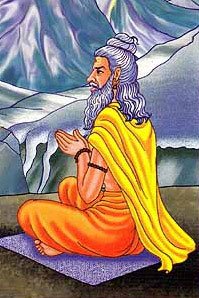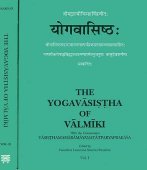Camatkara, Camatkāra: 15 definitions
Introduction:
Camatkara means something in Hinduism, Sanskrit, Jainism, Prakrit, Marathi, Hindi. If you want to know the exact meaning, history, etymology or English translation of this term then check out the descriptions on this page. Add your comment or reference to a book if you want to contribute to this summary article.
Alternative spellings of this word include Chamatkara.
In Hinduism
Purana and Itihasa (epic history)
Source: Wisdom Library: Skanda-puranaCamatkāra (चमत्कार) of Ānarta built and gifted a city to Brāhmaṇas. The city was named “Camatkārapura” after the name of the donor. It is called “Ānandapura” and “Nāgara”, synonyms of modern Vadnagara. It is the home of Nāgara Brāhmaṇas of Gujarat.
Source: archive.org: Puranic EncyclopediaCamatkāra (चमत्कार).—(See PATTU).

The Purana (पुराण, purāṇas) refers to Sanskrit literature preserving ancient India’s vast cultural history, including historical legends, religious ceremonies, various arts and sciences. The eighteen mahapuranas total over 400,000 shlokas (metrical couplets) and date to at least several centuries BCE.
In Jainism
General definition (in Jainism)
Source: The University of Sydney: A study of the Twelve ReflectionsCamatkāra (चमत्कार) refers to “astonishingly” [=camatkārakara?], according to the 11th century Jñānārṇava, a treatise on Jain Yoga in roughly 2200 Sanskrit verses composed by Śubhacandra.—Accordingly, “[com.—Next he speaks about the nature of asceticism]—Astonishingly (camatkāra—camatkārakaraṃ dhīrair), external [and] internal asceticism is undergone by honourable mendicants who are wise [and] alarmed by the continuous series of births [in the cycle of rebirth]. In that regard, external asceticism is declared to be of six kinds beginning with fasting while internal [asceticism] is also of [six] kinds on account of the divisions beginning with atonement”.
Synonyms: Āścaryakāraka (Āścaryakāra).

Jainism is an Indian religion of Dharma whose doctrine revolves around harmlessness (ahimsa) towards every living being. The two major branches (Digambara and Svetambara) of Jainism stimulate self-control (or, shramana, ‘self-reliance’) and spiritual development through a path of peace for the soul to progess to the ultimate goal.
Languages of India and abroad
Marathi-English dictionary
Source: DDSA: The Molesworth Marathi and English Dictionarycamatkāra (चमत्कार).—m (S) A wonder; an astonishing event, circumstance, appearance. 2 Wonder or astonishment. v hō, vāṭa.
Source: DDSA: The Aryabhusan school dictionary, Marathi-Englishcamatkāra (चमत्कार).—m A wonder; an astonishing event, circumstance, appearance. Wonder or astonishment.
Marathi is an Indo-European language having over 70 million native speakers people in (predominantly) Maharashtra India. Marathi, like many other Indo-Aryan languages, evolved from early forms of Prakrit, which itself is a subset of Sanskrit, one of the most ancient languages of the world.
Sanskrit dictionary
Source: DDSA: The practical Sanskrit-English dictionaryCamatkāra (चमत्कार).—f.
1) Admiration, surprise; एवं सकलजगत्त्रयहृदयचमत्कारकारिचरितानाम् (evaṃ sakalajagattrayahṛdayacamatkārakāricaritānām) Ks. 22.257.
2) Show, spectacle.
3) Poetical charm, that which constitutes the essence of poetry; चेतश्चमत्कृतिपदं कवितेव रम्या (cetaścamatkṛtipadaṃ kaviteva ramyā) Bv.3.16; तदपेक्षया वाच्यस्यैव चमत्कारित्वात् (tadapekṣayā vācyasyaiva camatkāritvāt) K. P.1.
4) Riot, festive or angry riot.
Derivable forms: camatkāraḥ (चमत्कारः).
See also (synonyms): camatkaraṇa, camatkṛti.
Source: Cologne Digital Sanskrit Dictionaries: Shabda-Sagara Sanskrit-English DictionaryCamatkāra (चमत्कार).—m.
(-raḥ) 1. Astonishment, surprise. 2. Show, spectacle. 3. Row, riot, festive or angry turbulence. 4. Elaborate style or high poetical composition. 5. The name of a tree: see apāmārga E. camat a sound of surprise, and kāra making. camadityavyaktaṃ kriyate kṛbhāve ghañ .
Source: Cologne Digital Sanskrit Dictionaries: Benfey Sanskrit-English DictionaryCamatkāra (चमत्कार).—[camat-kāra] (the latter part is kāra, the former questionable), n. Surprise, [Prabodhacandrodaya, (ed. Brockhaus.)] 76, 15.
Source: Cologne Digital Sanskrit Dictionaries: Monier-Williams Sanskrit-English Dictionary1) Camatkāra (चमत्कार):—[=camat-kāra] [from camat] m. astonishment, surprise, [Kathāsaritsāgara xxii, 257; Prabodha-candrodaya] etc.
2) [v.s. ...] show, spectacle, [Horace H. Wilson]
3) [v.s. ...] riot, festive turbulence, [Horace H. Wilson]
4) [v.s. ...] high poetical composition, [Horace H. Wilson]
5) [v.s. ...] Achyranthes aspera, [cf. Lexicographers, esp. such as amarasiṃha, halāyudha, hemacandra, etc.]
Source: Cologne Digital Sanskrit Dictionaries: Yates Sanskrit-English DictionaryCamatkāra (चमत्कार):—[cama-tkāra] (raḥ) 1. m. Surprise; spectacle; a riot; name of tree.
Source: DDSA: Paia-sadda-mahannavo; a comprehensive Prakrit Hindi dictionary (S)Camatkāra (चमत्कार) in the Sanskrit language is related to the Prakrit words: Camakka, Camakkāra, Camukkāra.
[Sanskrit to German]
Sanskrit, also spelled संस्कृतम् (saṃskṛtam), is an ancient language of India commonly seen as the grandmother of the Indo-European language family (even English!). Closely allied with Prakrit and Pali, Sanskrit is more exhaustive in both grammar and terms and has the most extensive collection of literature in the world, greatly surpassing its sister-languages Greek and Latin.
Hindi dictionary
Source: DDSA: A practical Hindi-English dictionaryCamatkāra (चमत्कार) [Also spelled chamatkar]:—(nm) a marvel, miracle; wonder; thaumaturgy; spectacle; ~[rika] thaumaturgic, marvellous, miraculous; spectacular; hence ~[rikatā; ~rī] miracuious; one who performs miracles, a thaumaturge.
...
Kannada-English dictionary
Source: Alar: Kannada-English corpusCamatkāra (ಚಮತ್ಕಾರ):—
1) [noun] an event that causes astonishment and admiration; a wonder.
2) [noun] skill; adroitness; adeptness.
3) [noun] quickness; swiftness.
4) [noun] (rhet.) pleasure, delight (derived from literature).
Kannada is a Dravidian language (as opposed to the Indo-European language family) mainly spoken in the southwestern region of India.
See also (Relevant definitions)
Partial matches: Camat, Kara, Cama.
Starts with: Camatkaracamikara, Camatkaracandrika, Camatkaracintamani, Camatkarajanya, Camatkarana, Camatkaranagara, Camatkaranem, Camatkaranritya, Camatkarapura.
Ends with: Acamatkara, Bharaticamatkara, Cittacamatkara, Svaratattvacamatkara, Vyavaharacamatkara.
Full-text (+8): Camatkriti, Camakka, Camatkaranritya, Camatkaracandrika, Camatkaracintamani, Camatkaranagara, Camakkara, Camatkarana, Camatukaratva, Camatu, Camatukriti, Sacamatkaram, Svaratattvacamatkara, Vyavaharacamatkara, Camukkara, Camatkarin, Camatkaranem, Camatkarita, Chamatkar, Nagara.
Relevant text
Search found 15 books and stories containing Camatkara, Camatkāra, Camat-kara, Camat-kāra, Cama-tkara, Cama-tkāra; (plurals include: Camatkaras, Camatkāras, karas, kāras, tkaras, tkāras). You can also click to the full overview containing English textual excerpts. Below are direct links for the most relevant articles:
Brihad Bhagavatamrita (commentary) (by Śrī Śrīmad Bhaktivedānta Nārāyana Gosvāmī Mahārāja)
Verse 1.7.55 < [Chapter 7 - Pūrṇa (pinnacle of excellent devotees)]
Verse 1.7.3-4 < [Chapter 7 - Pūrṇa (pinnacle of excellent devotees)]
Verse 1.5.108 < [Chapter 5 - Priya (the beloved devotees)]
Puranic encyclopaedia (by Vettam Mani)
Bhakti-rasamrta-sindhu (by Śrīla Rūpa Gosvāmī)
Verse 3.2.30 < [Part 2 - Affection and Service (dāsya-rasa)]
Verse 4.8.84 < [Part 8 - Compatible & Incompatible Mellows (maitrī-vaira-sthiti)]
Verse 1.3.44 < [Part 3 - Devotional Service in Ecstasy (bhāva-bhakti)]
Sahitya-kaumudi by Baladeva Vidyabhushana (by Gaurapada Dāsa)
Text 5.15 < [Chapter 5 - Second-rate Poetry]
Text 10.28 < [Chapter 10 - Ornaments of Meaning]
Text 9.37 [Citra-kāvya] < [Chapter 9 - Ornaments of Sound]
Chaitanya Bhagavata (by Bhumipati Dāsa)
Verse 1.15.154 < [Chapter 15 - Marriage with Śrī Viṣṇupriyā]
Verse 1.8.61 < [Chapter 8 - The Disappearance of Jagannātha Miśra]
Verse 2.1.35 < [Chapter 1 - The Beginning of the Lord’s Manifestation and His Instructions on Kṛṣṇa-saṅkīrtana]
The Skanda Purana (by G. V. Tagare)
Chapter 10 - King Camatkāra Cursed < [Section 1 - Tīrtha-māhātmya]
Chapter 17 - Vidūratha Goes Ahunting < [Section 1 - Tīrtha-māhātmya]
Chapter 11 - Gift of a City to Brāhmaṇas < [Section 1 - Tīrtha-māhātmya]
Related products
